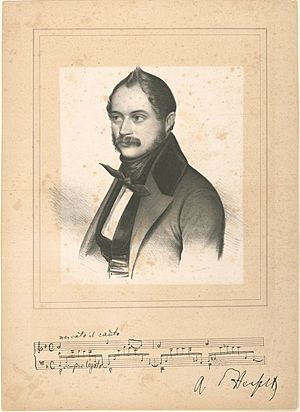Adolf von Henselt facts for kids
Georg Martin Adolf von Henselt (born May 9 or 12, 1814 – died October 10, 1889) was a famous German composer and a very skilled pianist. He was known for his beautiful piano playing and his unique musical style.
Contents
Life of a Piano Master
Henselt was born in Schwabach, a town in Bavaria, Germany. He started learning the violin at age three and the piano at age five. His first piano teacher was Josephe von Flad. She had studied with famous musicians like Franz Danzi and Franz Lauska.
Adolf gave his first public concert in Munich. He played music by Wolfgang Amadeus Mozart and Carl Maria von Weber. Thanks to his teacher's influence, King Ludwig I of Bavaria helped Henselt get money to study music further.
In 1832, he studied with Johann Nepomuk Hummel in Weimar. Later that year, he moved to Vienna. There, he studied composition with Simon Sechter, who also taught Anton Bruckner. Henselt became a successful concert pianist in Vienna.
To improve his health, he traveled around Germany in 1836. In 1837, he married Rosalie Vogel in Wrocław. The next year, he moved to Saint Petersburg, Russia, where he was already well-known.
Henselt became the court pianist for the Russian royal family. He also worked as an inspector of music studies at the Imperial Institute of Female Education. In 1876, he was given a special title of nobility. He usually spent his summer holidays in Germany. He visited England in 1852 and 1867, but he didn't perform publicly during his second visit. He lived in Saint Petersburg almost until he passed away from a heart problem while visiting Jelenia Góra, Germany (which is now in Poland).
Henselt's Playing Style
Many people thought Henselt's piano playing was a mix of Franz Liszt's powerful sound and Hummel's smooth style. His music was full of emotion and known for his use of wide chords and excellent technique. He was especially praised for his cantabile playing, which means playing in a singing, flowing way.
Liszt, another famous pianist, even told his students to "Find out the secret of Henselt's hands." Liszt once joked about how much effort Henselt put into his famous smooth playing, saying, "I could have had velvet paws like that if I had wanted to."
Henselt had a huge impact on the next generation of Russian pianists. His playing and teaching helped shape the Russian school of music, building on ideas from John Field. The famous composer Sergei Rachmaninoff greatly admired Henselt and saw him as a very important influence.
Henselt was best at playing his own music, as well as pieces by Carl Maria von Weber and Frédéric Chopin. His Piano Concerto in F minor, Op. 16, was once very popular in Europe. Among his many valuable studies, the Étude in F-sharp major, called Si oiseau j'étais (meaning "If I were a bird"), was especially well-liked. For a time, Henselt was second only to Anton Rubinstein in leading the Saint Petersburg Conservatory.
However, even though he lived a long life, Henselt mostly stopped composing by the time he was thirty. The reasons are not fully clear. He suffered from severe stage fright, which is a fear of performing in front of people. This fear was so strong that it was almost like paranoia. Because of this, he stopped giving public concerts by the age of thirty-three.
His Musical Works
Adolf von Henselt wrote many beautiful pieces, mostly for the piano. Here are some of the types of music he composed:
Piano Solo Pieces
Henselt wrote many pieces just for the piano. These include:
- Variations: Pieces where a main tune is repeated many times with changes.
- Études: These are special practice pieces designed to help pianists improve their skills, but they are also beautiful to listen to. His Douze Études caractéristiques (Twelve Characteristic Studies) and Douze Études de salon (Twelve Salon Studies) are well-known.
- Nocturnes: Calm and dreamy pieces, often inspired by the night.
- Impromptus: Pieces that sound like they were made up on the spot.
- Romances: Short, expressive, and often lyrical pieces.
- Waltzes and Polkas: Lively dance pieces.
- He also made arrangements of music by other composers, like Carl Maria von Weber and Ludwig van Beethoven, for the piano.
Orchestral Music
Henselt also wrote music for a full orchestra:
- Piano Concerto in F minor, Op. 16: This is a major work for piano and orchestra, where the piano is the main star.
Chamber Music
He wrote a few pieces for small groups of instruments:
- Duo, Op. 14: For cello and piano.
- Piano Trio in A minor, Op. 24: For piano, violin, and cello.
Vocal Music
Henselt also composed some songs for singers:
- Lieder: German songs for voice and piano.
- Choral works: Music for groups of singers.
Images for kids
See also
 In Spanish: Adolf von Henselt para niños
In Spanish: Adolf von Henselt para niños



